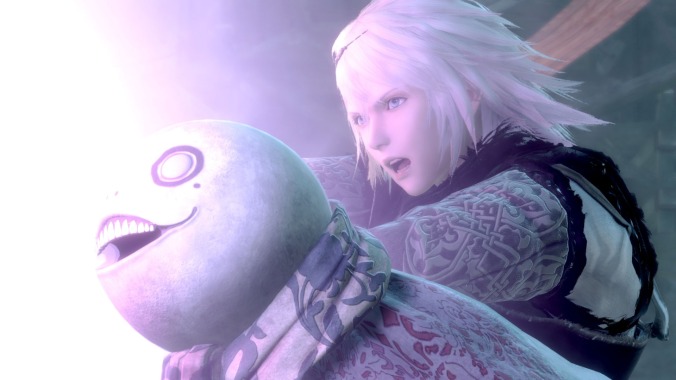Nier: Automata fans will love Nier: Replicant—eventually

Every Friday, A.V. Club staffers kick off our weekly open thread for the discussion of gaming plans and recent gaming glories, but of course, the real action is down in the comments, where we invite you to answer our eternal question: What Are You Playing This Weekend?
There’s a curious sort of amnesia that afflicts the players of Yoko Taro’s Nier series. It’s almost like one of those bizarre mystical diseases that are always threatening to destroy the games’ protagonists, and the teetering-on-the-edge-of-apocalypse worlds in which they live: Like magic, the moment you look away, the most annoying, frustrating, or boring parts of Nier’s designs always seem to fade from memory. What’s left behind, inevitably, are the highs, the moments of transcendent cleverness, narrative impact, or outright beautiful cruelty that writer and director Taro traffics in at his best. The phenomenon is pronounced enough that it feels shamefully petty, for instance, to note that 2017’s Nier: Automata—when it’s not breaking your heart, or blowing your mind— is mostly a game about doing tremendously tedious shit: Running endlessly through pretty but awkward environments. Swinging away on enemies with too-long health bars. Collecting crap off the ground. Doing those godawful, interminable top-down shooter sections. It’s a sort of magic trick. Taro and his team have made the best moments of their games incredibly memorable, and the worst a sort of nondescript, beige-y gray. The end result is that it takes precious little distance for the bad to fade and the good to remain, creating the impression of a masterpiece that is very much more than the sum of its (often deliberately irritating) parts.
Nier Replicant ver.1.22474487139…—the twee-ly named remake/update of Automata’s predecessor, which was released in different regions in 2010 as Nier: Gestalt, Nier: Replicant, or just plain Nier—doesn’t yet have that semi-mystical hindsight on its side. Given that it just came out yesterday, there’s been no time for its forest of raised middle fingers to undergo the gentle erosion of memory, transforming moments of aggressive annoyance into fun anecdotes instead of pointed “Fuck you”s. (We’re thinking here specifically of the bit where the game’s characters actively complain about its lack of a fast travel system—in a game where 80% of your time is spent traversing the same five or six bits of big-ass featureless plain.) And, admittedly, Replicant shaves off many of the rougher edges of the original Nier’s design: The environments no longer look like they were stolen from a random Mass Effect planet that was then slathered in Vaseline, and the combat, overseen by PlatinumGames’ Takashi Taura, feels roughly as crisp as the vastly improved Automata’s. But no amount of remastery can change Taro himself, or his basic design ethos, which prizes cleverness over comfort, and impact over enjoyment, both to the detriment of the moment-to-moment play.
Take as indicative an early sequence spent in the game’s Barren Temple, located near the rule-obsessed kingdom of Facade. Is it clever that the temple imposes a set of combat restrictions on your young hero, Nier, forcing him to restart rooms every time he breaks them so as to demonstrate the maddening nature of the law-bound nation? Sure. Is it any damn fun? Not remotely. But that frustration is, presumably, what Taro is going for. Ditto the bit that blanks the game screen out and shifts into a visual novel/choose your own adventure-style game… and then kills you (complete with a Game Over) any time you make the wrong choice.
The thing about Taro is that he’s possibly unique among major game designers, in that he has almost zero interest in making his games enjoyable on a moment-to-moment basis. (Even Hideo Kojima, gaming’s most famous troll, tends to try to make his most goofy excesses basically fun.) This dedication to irritation is artistically bold, yes. But it’s also a strange kind of irresponsible, a reminder of why we do not, in fact, do it like this. Say what you like about Michael Haneke films, but at least they’re over after two hours; Nier wants you to stew in its boredom, annoyance, and misery for at least the better part of a full day. (And considerably more, if you’re going for each of its endings.) The game isn’t relentlessly dour, but it’s so reserved in handing out satisfaction as to frequently fatigue.
Is it worth it? Annoyingly, the answer is likely to land somewhere near “probably, eventually” for a lot of folks. Automata players may struggle at first with some of the game’s hostilities, but all of the things they enjoyed about the sequel are still here, if just slightly more obscured. And despite ourselves, we can already feel the tedium of Nier—the repetitive dialogue; the meaningless busywork of sidequests; the endless, fucking endless running to get anywhere in its too-big world—starting to protectively erase itself from our minds. Six months from now, we won’t think about what a huge pain in the ass it was to get around the game’s haunted mansion; we’ll just remember how neat it was to notice that it was basically a carbon copy of the setting of the first Resident Evil. When we look back, it won’t be with hands cramping from too-long fights, or the endless ticking annoyance of navigating painfully convoluted menus. Instead, we’ll be thinking about the rich and enjoyable relationship between Nier and his well-drawn companions, Emil, Kainé, and Weiss. Or the pleasures of smacking down giant, gorgeously designed monsters. Or the high-melodrama nastiness of the game’s most sweeping plot reveals. Right now, Nier: Replicant is a frustrating and annoying mess to play. We can’t wait to be looking back and remembering it, instead.